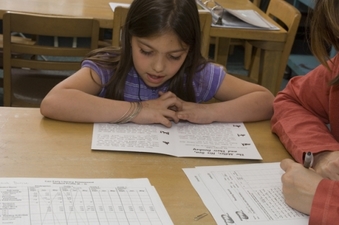Definition
Repeated readings is when a student reads the same text over and over again until the rate of reading has no errors. This strategy can be done individually or in a group setting. This method was originally targeted for students with learning disabilities until educators realized that all students can benefit from this strategy.
Repeated readings is when a student reads the same text over and over again until the rate of reading has no errors. This strategy can be done individually or in a group setting. This method was originally targeted for students with learning disabilities until educators realized that all students can benefit from this strategy.
|
Steps of Repeated Reading:
1: Sit with the student in a quiet location without too many distractions. Position the book selected for the reading session so that both you and the student can easily follow the text. 2: Select a passage in the book of about 100 to 200 words in length. 3: Have the student read the passage through. (Unless you have a preference, the student should be offered the choice of reading the passage aloud or silently.) 4: If the student is reading aloud and misreads a word or hesitates for longer than 5 seconds, read the word aloud and have the student repeat the word correctly before continuing through the passage. If the student asks for help with any word, read the word aloud. If the student requests a word definition, give the definition. 5: When the student has completed the passage, have him or her read the passage again. You can choose to have the student read the passage repeatedly until either the student has read the passage a total of 4 times or the student reads the passage at the rate of at least 85 to 100 words per minute (Cox, 2015). Checklist for Reading PurposesBefore Reading
During Reading
After Reading
Repeated Reading Lesson ExamplesDifferentiated Instruction
|
Purpose
Repeated readings are used to help students develop fluency and comprehension. This method was designed to help students who have little to no experience with reading fluently to gain confidence, speed and process words automatically (Cox, 2015). Other benefits of repeated readings include helping all readers with fact recall, serves as a study strategy, aids in students' identification of what's important in their reading, such as main ideas and vocabulary, increases comprehension and results in more advanced questioning and insight, leads to faster reading and increased word recognition accuracy, and assists struggling readers as they transition from word-by-word reading to more meaningful phrasing (AEA, 2015). In this video above the teacher goes though an example of how repeated readings works. This is just one form of it there are other ways it can be given. She has the student read as much as he can in one minute and then marks on a graph how many correct words that were read. Then she repeats this three more times to show the students progress in fluency and amount of words read.
Activities/Forms of Repeated Readings
Content Areas
Math- In math repeated readings can be facilitated to practice with certain vocabulary or sentence structure. If a student is struggling with comprehension of math reading the material over again could help a student to think about what they are reading and dig deeper into what each term means after reading each round.
Science- In science there can be a lot of information in a small amount of reading. If a student struggles with comprehension in science repeated reading might be an strategy to try. Not only could the student be working on their fluency of reading but their comprehension of the content of other subjects such as science. Social Studies- This subject area can be difficult one because of the amount of information as well as the difficulty of the content. Like science many of the vocabulary words that come up in social studies are new or ones students don't use on a regular basis so it is good to practice them. Through repeated reading once again student can work on fluency and comprehension of this particular content area. Repeated reading is also a great study strategy. Reading- Reading is the most common form of repeated reading because it is the subject where it originated. Students who struggle with fluency and comprehension need repeated exposure to the content to get the information to solidify. By reading a passage and getting further and further each time, the students' reading gets to be faster and better put together because of the practice and error correction each round. |
References
Repeated Reading. (2015). Retrieved October 2, 2015, from http://www.interventioncentral.org/academic-interventions/reading-fluency/repeated-reading
Cox, J. (2015). Repeated Reading - Fluency and Comprehension Strategy. Retrieved October 2, 2015, from http://k6educators.about.com/od/ReadingStrategies/a/Repeated-Reading-Fluency-Strategy.htm
Surchy, S. (2010, July 30). Repeated Reading. Retrieved October 2, 2015, from https://www.youtube.com/watch?v=AJ6WGHgeNRE
Structured Repeated Reading | AEA 267 English Language Arts. (2015). Retrieved October 2, 2015, from https://www.aea267.k12.ia.us/english-language-arts/reading/fluency/structured-repeated-reading/
(2010). Retrieved October 2, 2015, from http://teacher.scholastic.com/reading/bestpractices/fluency/pdfs/building_fluency_repeatedreading.pdf
Timed Repeated Readings. (2015). Retrieved October 2, 2015, from http://www.readingrockets.org/strategies/timed_repeated_readings
Repeated Reading. (2015). Retrieved October 2, 2015, from http://www.interventioncentral.org/academic-interventions/reading-fluency/repeated-reading
Cox, J. (2015). Repeated Reading - Fluency and Comprehension Strategy. Retrieved October 2, 2015, from http://k6educators.about.com/od/ReadingStrategies/a/Repeated-Reading-Fluency-Strategy.htm
Surchy, S. (2010, July 30). Repeated Reading. Retrieved October 2, 2015, from https://www.youtube.com/watch?v=AJ6WGHgeNRE
Structured Repeated Reading | AEA 267 English Language Arts. (2015). Retrieved October 2, 2015, from https://www.aea267.k12.ia.us/english-language-arts/reading/fluency/structured-repeated-reading/
(2010). Retrieved October 2, 2015, from http://teacher.scholastic.com/reading/bestpractices/fluency/pdfs/building_fluency_repeatedreading.pdf
Timed Repeated Readings. (2015). Retrieved October 2, 2015, from http://www.readingrockets.org/strategies/timed_repeated_readings

